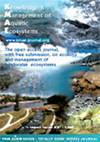入侵的克氏原螯虾与小管Pomacea共生对高密度水藻(Vallisneria denseserrulata)为主的淡水生态系统的影响
IF 1.7
3区 环境科学与生态学
Q3 FISHERIES
引用次数: 5
摘要
单一入侵者通常会极大地改变生态系统,但多种入侵者的潜在影响仍未得到充分研究。金苹果蜗牛(Pomacea canaliculata)和红沼泽小龙虾(Procambarus clarkii)是两种广泛的共同入侵者。为了测试两种物种共存对淡水大型植物状态的影响,我们在16个中生态系统(4个只含2只蜗牛,4个只含2只小龙虾,4个含2只蜗牛和2只小龙虾,4个对照)中进行了为期20天的实验。与对照相比,只放蜗牛和只放小龙虾处理的密叶缬草叶长、叶数和生物量均有所减少。小龙虾处理的总氮、总磷和总悬浮物均较对照增加,而蜗牛处理与对照无显著差异。钉螺+小龙虾处理与纯钉螺处理的营养物和浊度浓度无显著差异,钉螺+小龙虾处理与纯钉螺处理的植物生物量无显著差异。这些结果表明,金苹果螺主要通过植物放牧影响湖泊生态系统,而红沼泽小龙虾则通过增加水中养分和再悬浮来扰乱沉积物。这些蜗牛和小龙虾共同对大型植物和所研究的物理化学变量具有主要的加性作用。本文章由计算机程序翻译,如有差异,请以英文原文为准。
Effects of co-occurrence of invading Procambarus clarkii and Pomacea canaliculata on Vallisneria denseserrulata-dominated clear-water ecosystems: a mesocosm approach
Single invaders often substantially alter ecosystems, but the potential impacts by multiple invaders remain understudied. The golden apple snail (Pomacea canaliculata) and the red swamp crayfish (Procambarus clarkii) are two widespread coinvaders. To test the effects of co-occurrence of the two species on a clear-water macrophyte state, we performed a 20-day experiment in 16 mesocosms (4 contained only two snails, 4 contained only two crayfishes, 4 contained two snails and two crayfishes, and 4 controls). Comparing with the control, the leaf length, number, and biomass of Vallisneria denseserrulata had decreased in the snail-only and crayfish-only treatments. In the crayfish-only treatment, total nitrogen, total phosphorus and total suspended solids had increased compared with the control, while they did not differ between the snail-only and the control treatment. Nutrients and turbidity concentrations did not differ between the snail + crayfish and the crayfish-only treatment, and plant biomass did not differ between the snail + crayfish and the snail-only treatment. These findings suggest that golden apple snails mainly affected the lake ecosystem by plant grazing, while red swamp crayfishes disturbed the sediment by increasing nutrients in the water and through resuspension. These snail and crayfish together had mainly additive effects on macrophyte and the physico-chemical variables studied.
求助全文
通过发布文献求助,成功后即可免费获取论文全文。
去求助
来源期刊

Knowledge and Management of Aquatic Ecosystems
环境科学-海洋与淡水生物学
CiteScore
3.70
自引率
5.60%
发文量
22
审稿时长
>12 weeks
期刊介绍:
Knowledge and Management of Aquatic Ecosystems (KMAE-Bulletin Français de la Pêche et de la Pisciculture since 1928) serves as a foundation for scientific advice across the broad spectrum of management and conservation issues related to freshwater ecosystems.
The journal publishes articles, short communications, reviews, comments and replies that contribute to a scientific understanding of freshwater ecosystems and the impact of human activities upon these systems. Its scope includes economic, social, and public administration studies, in so far as they are directly concerned with the management of freshwater ecosystems (e.g. European Water Framework Directive, USA Clean Water Act, Canadian Water Quality Guidelines, …) and prove of general interest to freshwater specialists. Papers on insular freshwater ecosystems and on transitional waters are welcome. KMAE is not a preferred journal for taxonomical, physiological, biological, toxicological studies, unless a clear link to ecological aspects can be established. Articles with a very descriptive content can be accepted if they are part of a broader ecological context.
 求助内容:
求助内容: 应助结果提醒方式:
应助结果提醒方式:


